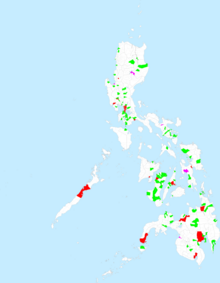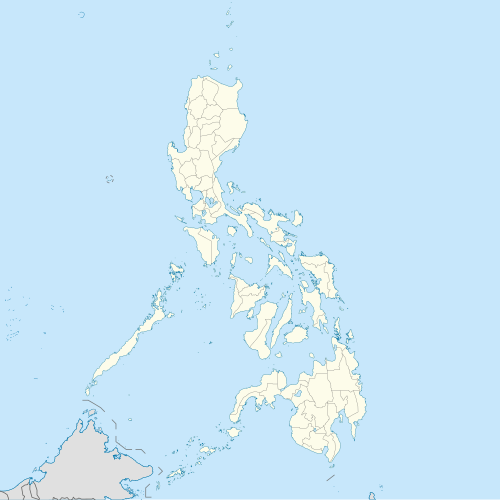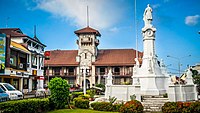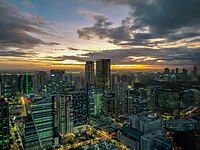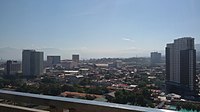
In the Philippines, provinces are one of its primary political and administrative divisions. There are 82 provinces at present, which are further subdivided into component cities and municipalities. The local government units in the National Capital Region, as well as independent cities, are independent of any provincial government. Each province is governed by an elected legislature called the Sangguniang Panlalawigan and an elected governor.
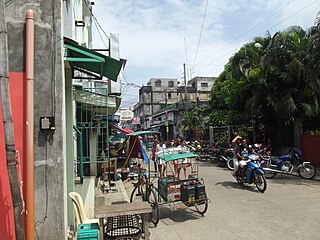
Naval, officially the Municipality of Naval, is a 2nd class municipality and capital of the province of Biliran, Philippines. According to the 2020 census, it has a population of 58,187 people.

Buluan, officially the Municipality of Buluan, is a 4th class municipality and capital of the province of Maguindanao del Sur, Philippines. According to the 2020 census, it has a population of 57,406 people.

San Jose, officially the Municipality of San Jose, is a 4th class municipality and capital of the province of Dinagat Islands, Philippines. According to the 2020 census, it has a population of 26,375 people.

Palayan, officially the City of Palayan, is a 5th class component city and capital of the province of Nueva Ecija, Philippines. According to the 2020 census, it has a population of 45,383 people, making it the least populated city in the Philippines.
The legislative district of San Juan–Mandaluyong was the combined representation of the Metropolitan Manila municipalities of Mandaluyong and San Juan in the Regular Batasang Pambansa (1984–1986) and the lower house of the Congress of the Philippines (1987–1995).

The legislative districts of Cebu are the representations of the province of Cebu in the various national legislatures of the Philippines. At present, the province is currently represented in the House of Representatives of the Philippines by its seven congressional districts, with their respective representatives being elected every three years. Locally, the districts are also allotted two seats in the Cebu Provincial Board, with board members also being elected every three years.
The legislative districts of Cebu City are the representations of the highly urbanized city of Cebu in the various national legislatures of the Philippines. The city is currently represented in the lower house of the Congress of the Philippines through its first and second congressional districts.
The legislative districts of Leyte are the representations of the province of Leyte, the independent component city of Ormoc, and highly urbanized city of Tacloban in the various national legislatures of the Philippines. The province, together with the independent cities are currently represented in the lower house of the Congress of the Philippines through their first, second, third, fourth, and fifth congressional districts.
The legislative districts of Cotabato are the representations of the province of Cotabato in the various national legislatures of the Philippines. The province is currently represented in the lower house of the Congress of the Philippines through its first, second, and third congressional districts.
The legislative districts of South Cotabato are the representations of the province of South Cotabato and the urbanized city of General Santos in the various national legislatures of the Philippines. The province is currently represented in the lower house of the Congress of the Philippines through its first and second congressional districts.
The legislative district of Lanao was the representation of the historical province of Lanao in the various national legislatures of the Philippines until 1969. Marawi and Iligan also remained part of the province's representation even after becoming chartered cities in 1940 and 1950, respectively.
The legislative districts of Lanao del Sur are the representations of the province of Lanao del Sur in the various national legislatures of the Philippines. The province is currently represented in the lower house of the Congress of the Philippines through its first and second congressional districts.
The legislative districts of Misamis Oriental are the representations of the province of Misamis Oriental in the various national legislatures of the Philippines. The province is currently represented in the lower house of the Congress of the Philippines through its first and second congressional districts.
In the Philippines, local government is divided into three levels: provinces and independent cities, component cities and municipalities, and barangays, all of which are collectively known as local government units (LGUs). In some areas, above provinces and independent chartered cities are autonomous regions, such as the Bangsamoro Autonomous Region in Muslim Mindanao. Some towns and cities remit their revenue to national government and is returned through the national government through a process called internal revenue allotment. Below barangays in some cities and municipalities are sitios and puroks. All of these, with the exception of sitios and puroks, elect their own executives and legislatures. Sitios and puroks are often but not necessarily led by an elected barangay councilor.

Batangas's 2nd congressional district is one of the six congressional districts of the Philippines in the province of Batangas. It has been represented in the House of Representatives of the Philippines since 1916 and earlier in the Philippine Assembly from 1907 to 1916. The district consists of the southern Batangas municipalities of Bauan, Lobo, Mabini, San Luis, San Pascual and Tingloy. It is currently represented in the 19th Congress by Gerville Luistro of Lakas-CMD.
Referendums in the Philippines are occasionally held at a national, regional or local level. Referendums can either by national or local in scope. In the Philippines, "referendums" and "plebiscites" mean different things.
Parañaque's at-large congressional district may refer to three occasions when a city-wide or provincewide at-large Congressional district was used for elections to the Philippine House of Representatives from Parañaque in the Philippines.

A plebiscite was held in the province of Bulacan, Philippines, on October 30, 2023, with the purpose of determining if San Jose del Monte should be converted into a highly urbanized city. If carried, San Jose del Monte will be politically, fiscally, and administratively independent from Bulacan; if rejected, the city will remain a component city of Bulacan.
